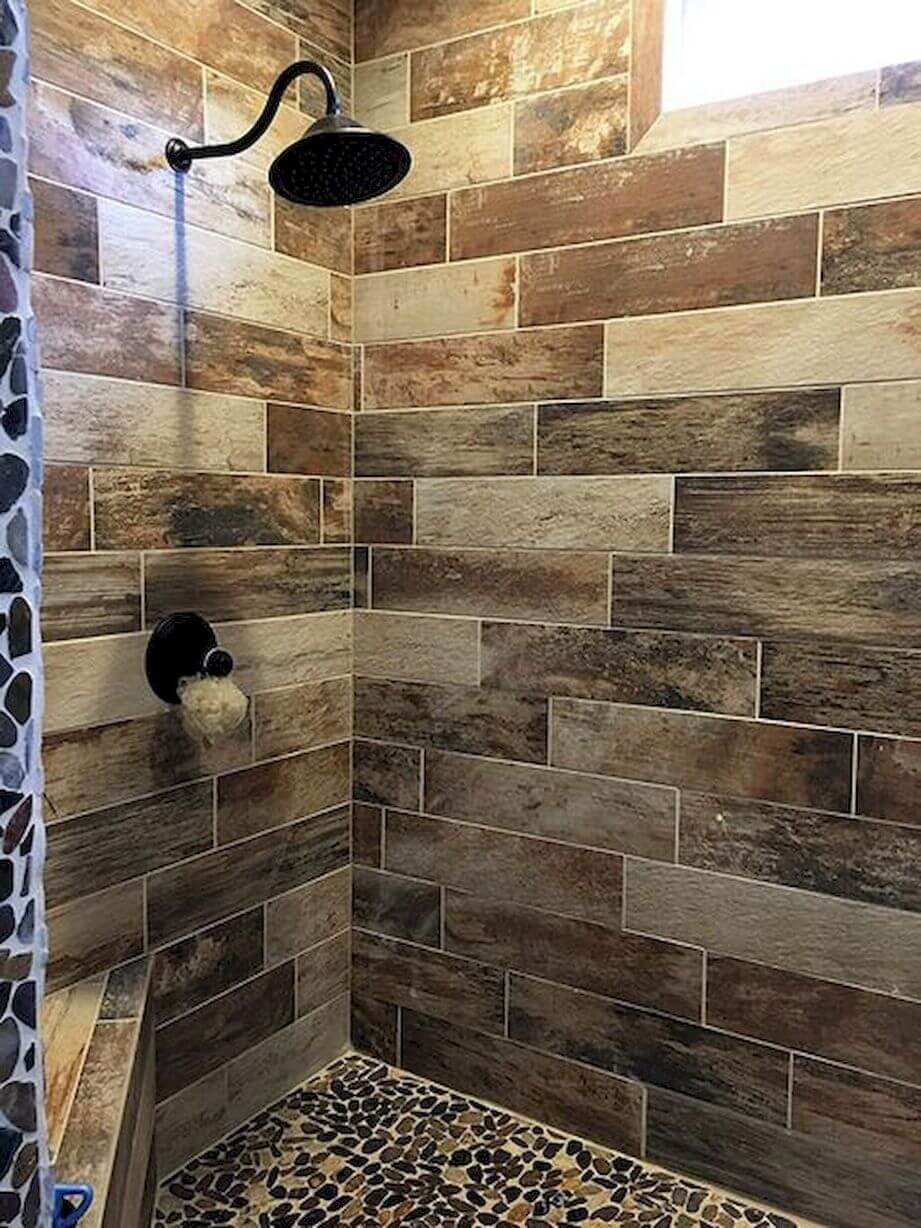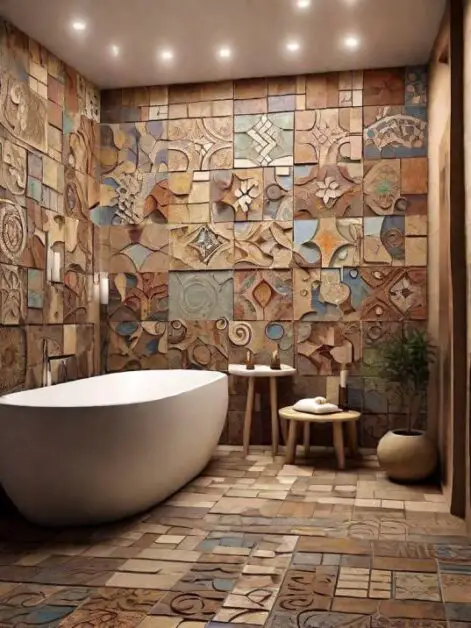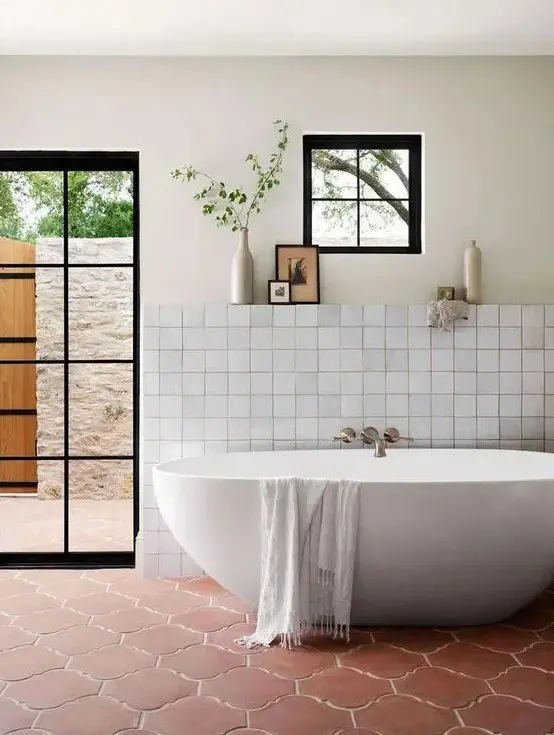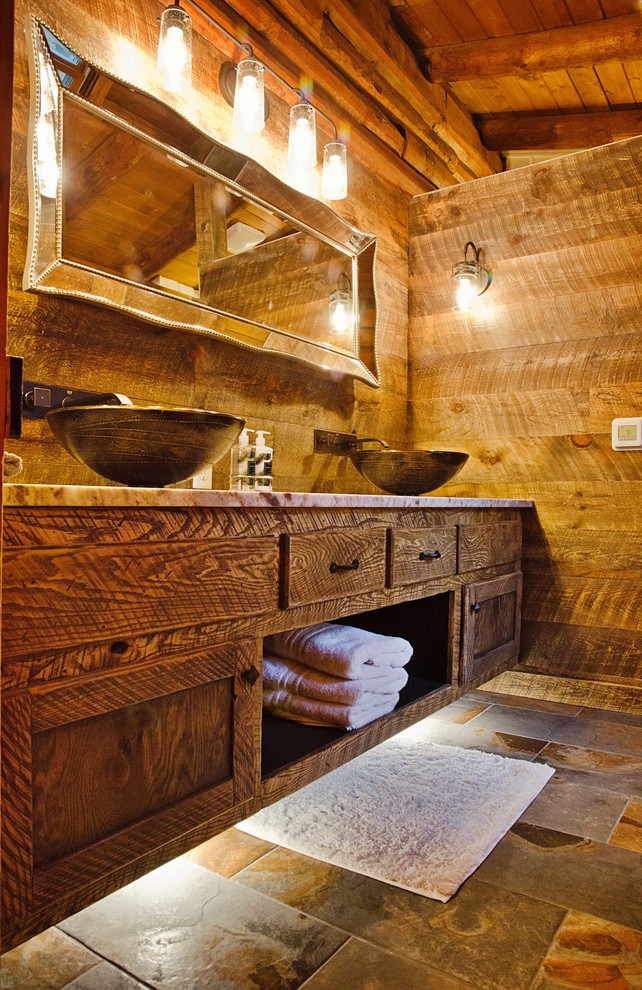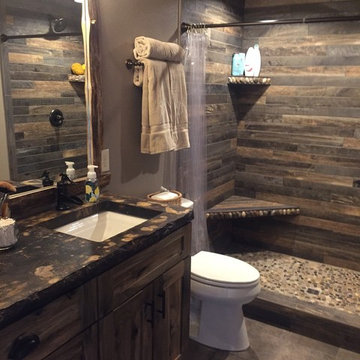Natural Stone Tiles: Bringing the Outdoors In
Natural stone tiles are a perfect choice for anyone looking to create a rustic bathroom that feels grounded in nature. These tiles, made from materials like slate, marble, granite, or limestone, bring a raw, organic feel to your space, echoing the beauty of the natural world. Their texture and irregularities are exactly what make them so attractive for rustic bathroom designs.
- Embracing the Earthy Vibes
Natural stone tiles, with their raw textures and earthy tones, effortlessly bring a slice of the outdoors into your bathroom. Whether you opt for slate’s rugged look, the sleekness of marble, or the subtle warmth of travertine, these materials add depth and character. Their naturally varied appearance ensures that no two tiles are the same, giving your bathroom a personalized, one-of-a-kind look. - Durability with Timeless Appeal
One of the standout features of natural stone is its durability. These materials have been used for centuries, chosen for their ability to withstand the test of time. In a bathroom, where moisture and heat are constant, natural stone tiles maintain their integrity while adding a timeless rustic appeal. Their weather-resistant properties also make them a low-maintenance option. - Variations in Finish for Unique Style
Natural stone tiles are available in different finishes, each adding a unique touch to the bathroom. Polished marble brings a touch of elegance to rustic spaces, while honed or tumbled stone provides a more weathered, raw appearance. Opting for a matte or textured finish enhances the rustic, unrefined aesthetic that these designs often aim for. - Pairing with Wood and Metal
To complement the rugged look of stone tiles, many designers incorporate natural wood and metal elements. Exposed wooden beams or cabinetry made from reclaimed wood blend seamlessly with stone, adding warmth and balance to the room. Metal fixtures in matte black, antique brass, or copper also add a striking contrast to the organic textures of the stone tiles. - Large Format vs. Small Tiles
When selecting natural stone tiles, the size and format you choose can greatly affect the overall design. Large-format stone tiles create a more modern rustic look, with fewer grout lines and a cleaner, more expansive feel. On the other hand, small, mosaic-style stone tiles or irregularly shaped stones enhance the rugged, handcrafted vibe that’s central to rustic design. - Maintenance Considerations
Although natural stone tiles are beautiful and durable, they require regular maintenance to keep them looking their best. Sealing the tiles periodically protects them from moisture and stains, which is particularly important in a bathroom setting. Choosing a high-quality sealant and maintaining a cleaning routine can help preserve the tiles’ natural beauty for years.

Wood-Look Tiles: Capturing Rustic Charm with Durability
For those who love the look of wood but need the practicality of tile, wood-look tiles are the perfect solution. These tiles mimic the appearance of natural wood while providing the durability and water resistance necessary for a bathroom. They allow homeowners to bring warmth and rustic charm to their space without compromising on function.
The Appeal of Wood-Look Tiles
Wood has long been a staple in rustic design, but it isn’t always the most practical choice for bathrooms, where moisture can warp and damage real wood. Wood-look tiles, typically made from porcelain or ceramic, provide the aesthetic of wood planks while offering the water resistance and durability of tile. This combination makes them ideal for rustic bathrooms.
Variety in Patterns and Shades
Wood-look tiles come in an impressive array of patterns, colors, and finishes, allowing homeowners to create a customized look. Whether you prefer the warmth of a rich walnut tone or the light, airy feel of a whitewashed oak, there’s a wood-look tile to match your vision. These tiles can also be laid in different patterns, such as herringbone or staggered planks, for added visual interest.
Durability Meets Design
The practicality of wood-look tiles cannot be overstated. Unlike real wood, these tiles are resistant to water, stains, and scratches, making them a durable option for high-traffic areas like bathrooms. They also maintain their appearance over time, without the need for refinishing or treatment, making them a low-maintenance alternative to traditional wood flooring.
Blending with Natural Elements
Wood-look tiles work beautifully alongside other natural elements in a rustic bathroom, such as stone or metal. The warm tones of the wood-look tiles complement cool stone textures, creating a balanced, harmonious aesthetic. Pairing these tiles with metal fixtures in rustic finishes, such as matte black or oil-rubbed bronze, further enhances the industrial charm.
Eco-Friendly Options
Many wood-look tiles are produced using environmentally friendly practices, making them a great choice for eco-conscious homeowners. By choosing tiles instead of real wood, you can achieve the same rustic charm without contributing to deforestation. Additionally, porcelain and ceramic tiles are often made from sustainable materials and are recyclable.
Maintenance-Free Wood Appeal
Wood-look tiles offer the charm of wood without the need for extensive upkeep. Unlike real wood, which requires sealing, staining, and regular care, these tiles are easy to clean and maintain. A simple wipe with a damp cloth or mop is usually sufficient to keep them looking great, making them an excellent choice for busy households.
Handcrafted Tiles: Adding a Unique, Artisanal Touch
For a truly unique and personalized rustic bathroom, handcrafted tiles are an excellent choice. These tiles, often made by artisans, bring a sense of individuality and craftsmanship to the space. Their imperfections and irregularities are part of their charm, giving your bathroom a bespoke, one-of-a-kind look.
The Beauty of Handcrafted Tiles
Handcrafted tiles offer a distinct aesthetic that mass-produced tiles cannot replicate. Each tile is individually made, often with slight variations in color, texture, and shape, which adds to their rustic charm. Whether they are hand-painted, molded, or glazed, these tiles bring an artisanal touch to your bathroom that’s impossible to achieve with machine-made alternatives.
Unique Patterns and Designs
One of the advantages of handcrafted tiles is the ability to customize patterns and designs. Artisans often create intricate motifs or textures that reflect personal style, nature, or traditional techniques. These tiles can be used as a focal point, such as in a feature wall or backsplash, to draw attention and add character to your rustic bathroom.
Imperfection as Perfection
In rustic design, imperfections are celebrated rather than hidden, and handcrafted tiles embody this principle perfectly. Their slightly uneven edges, varying glazes, or subtle color variations add to their appeal. These imperfections give the bathroom a sense of history and warmth, making the space feel lived-in and authentic.
Pairing with Natural Materials
Handcrafted tiles pair beautifully with natural materials like stone, wood, and metal. Their organic shapes and textures complement the rugged beauty of these elements, enhancing the rustic aesthetic. For example, handcrafted tiles with a matte glaze can create a stunning contrast when paired with sleek, polished stone countertops or weathered wood cabinetry.
Supporting Artisans and Small Businesses
By choosing handcrafted tiles, you’re often supporting local artisans and small businesses, many of which prioritize sustainable and ethical production practices. This choice not only brings unique, artistic elements to your home but also contributes to the preservation of traditional craftsmanship.
Care and Maintenance
Handcrafted tiles may require a bit more care than mass-produced options, especially if they are made from porous materials like clay or terracotta. Sealing them can help protect against water and stains, but regular maintenance is key to preserving their beauty. That said, the unique, artisanal quality of handcrafted tiles makes them well worth the effort.
Terracotta Tiles: Embracing Earthy Warmth and Texture
Terracotta tiles are a classic choice for rustic bathroom designs, known for their rich, earthy tones and natural texture. Made from baked clay, these tiles exude warmth and bring an inviting, grounded feel to any space. Their timeless appeal and durability make them a favorite in rustic bathrooms.
The Natural Warmth of Terracotta
Terracotta, which translates to “baked earth,” is synonymous with rustic design. Its warm, reddish-brown hues evoke the natural beauty of the earth, making it a perfect choice for creating a cozy, inviting bathroom. These tiles are available in a variety of shapes and sizes, from large floor tiles to smaller mosaic patterns, allowing for versatility in design.
Textured Appeal
Terracotta tiles often have a textured, matte finish that enhances their rustic aesthetic. Their surface may be slightly rough or uneven, which adds to their charm and helps create a timeworn, lived-in look. This texture not only adds visual interest but also makes the tiles less slippery, a practical consideration for bathroom floors.
Handmade Variations
Many terracotta tiles are handmade, resulting in slight variations in color, shape, and texture from one tile to the next. These variations are part of the appeal, as they give the bathroom a natural, organic feel. The irregularities in the tiles’ surface create a unique, handcrafted look that enhances the rustic vibe of the space.
Pairing with Mediterranean or Southwestern Styles
Terracotta tiles are often associated with Mediterranean and Southwestern design styles, making them a natural fit for rustic bathrooms that draw inspiration from these regions. They pair beautifully with other natural materials like wood, stone, and wrought iron, creating a cohesive and warm aesthetic that feels both earthy and elegant.
Durability and Longevity
Terracotta tiles are incredibly durable and can last for decades with proper care. Their natural composition makes them resistant to wear and tear, though they may require sealing to protect against water damage, especially in a bathroom. Once sealed, they become more water-resistant and easier to maintain, making them a practical choice for high-moisture areas.
Easy Maintenance and Care
While terracotta tiles do require sealing, they are generally easy to maintain once properly treated. Regular cleaning with a mild soap and water solution will keep them looking fresh, while resealing every few years ensures they remain water-resistant. The combination of beauty, durability, and ease of care makes terracotta tiles a popular choice for rustic bathrooms.
Weathered and Distressed Tiles: Creating a Timeworn Appeal
Incorporating weathered and distressed tiles into your rustic bathroom design adds a sense of history and character. These tiles are designed to look aged, with faded colors, chipped edges, and worn surfaces that evoke the feeling of a well-loved, lived-in space. Their timeworn appeal is central to the rustic aesthetic.
The Charm of Imperfection
Distressed and weathered tiles embrace the beauty of imperfection. Whether naturally aged or intentionally designed to look old, these tiles give your bathroom a lived-in, vintage feel. Their chipped edges, worn surfaces, and faded colors create a sense of history, as though the space has been well-used and well-loved over time.
Vintage Appeal with Modern Durability
While distressed tiles look as though they’ve been around for decades, they are often made with modern techniques that ensure durability and longevity. This means you get the best of both worlds: the charm of aged materials with the practicality of modern tile. These tiles are typically made from ceramic or porcelain, which are both durable and easy to maintain.
Mixing with Other Textures
Weathered tiles pair beautifully with other rustic elements like wood, stone, and metal. For example, distressed tiles on the floor can complement a reclaimed wood vanity or exposed brick wall. The combination of different textures creates a rich, layered aesthetic that adds depth and interest to the bathroom.
Creating Focal Points
Distressed tiles work especially well as focal points in a rustic bathroom. Whether used in a shower surround, as a feature wall, or as a backsplash, these tiles draw the eye and add character to the space. Because of their unique appearance, they’re often used sparingly to create a striking design element that enhances the room’s overall rustic theme.
A Timeworn Color Palette
Distressed tiles often come in muted, faded colors that evoke the passage of time. Soft blues, pale greens, and weathered whites are common choices that add a calming, vintage feel to the bathroom. These subtle colors work well with the natural materials commonly used in rustic design, creating a cohesive and harmonious look.
Maintenance and Longevity
Despite their aged appearance, weathered and distressed tiles are typically made to last. Like other ceramic or porcelain tiles, they are water-resistant and easy to clean, making them a practical choice for bathroom spaces. With minimal maintenance, they can retain their vintage charm for years to come, offering both style and functionality.
Mosaic Tile Patterns: Infusing Rustic Bathrooms with Artistic Flair
Mosaic tiles are a great way to add artistic flair to a rustic bathroom. While they are often associated with more traditional or modern designs, rustic mosaic tiles can be used to create intricate patterns and designs that enhance the overall aesthetic of the space. From natural stone to distressed ceramics, mosaic tiles offer endless possibilities for customization.
The Artistic Appeal of Mosaics
Mosaic tiles allow for creative expression, offering the opportunity to incorporate intricate patterns, geometric shapes, or even nature-inspired motifs into your bathroom design. In a rustic bathroom, these tiles can be made from natural materials like stone, terracotta, or ceramic, bringing a handcrafted, artistic touch to the space.
Adding Intricacy with Small Tiles
Mosaic tiles are typically small, allowing for detailed designs that can transform a bathroom. Whether used to create a stunning backsplash or an accent wall, these tiles add depth and intricacy to the space. For a rustic look, opt for materials with natural textures and earthy tones, such as slate, pebble, or wood-look tiles.
Blending Rustic and Modern Elements
Mosaic tile patterns can bridge the gap between rustic and modern design elements. For example, pairing a rustic mosaic floor with sleek, modern fixtures creates an interesting juxtaposition that adds depth to the space. The key is to keep the color palette and materials cohesive, sticking with earthy tones and natural finishes for the mosaic tiles.
Creating Custom Designs
One of the greatest advantages of mosaic tiles is the ability to create custom designs. In a rustic bathroom, consider using mosaic tiles to craft a nature-inspired motif, such as leaves, vines, or water patterns. These custom designs can serve as a focal point, bringing a personal, artistic touch to your space.
Durability and Practicality
Mosaic tiles are often made from durable materials like stone, ceramic, or porcelain, making them a practical choice for bathroom spaces. They are water-resistant and easy to clean, and their small size allows for greater flexibility in design, particularly in areas with curves or unusual shapes, such as around a bathtub or shower.
Incorporating Color and Texture
While rustic bathrooms typically favor neutral, earthy tones, mosaic tiles offer the opportunity to introduce subtle pops of color or texture into the design. Consider using contrasting shades or different finishes within the mosaic to add visual interest without overpowering the room’s natural, rustic aesthetic.
Mixing and Matching Textures: Elevating Rustic Aesthetics through Contrast
One of the hallmarks of rustic design is the layering of textures, and bathroom tile design is no exception. By mixing and matching different tile textures, you can create a visually dynamic and engaging space that feels both cozy and sophisticated. This approach allows you to balance the rough with the smooth, the matte with the polished, and the old with the new.
The Importance of Texture in Rustic Design
Texture is a key element in rustic design, helping to create a sense of warmth, depth, and authenticity. By mixing and matching different textures in your tile choices—such as pairing smooth marble with rough-hewn stone—you can elevate the rustic aesthetic and bring a sense of balance to the bathroom. The contrast between these materials adds visual interest without overwhelming the space.
Combining Smooth and Rough Textures
One effective way to mix textures is by combining smooth tiles with rougher, more tactile surfaces. For example, polished stone tiles on the walls can be paired with rough slate or distressed wood-look tiles on the floor. This contrast not only enhances the rustic vibe but also creates a tactile experience that makes the bathroom feel more engaging and layered.
Matte vs. Glossy Finishes
Another way to mix textures is by playing with different finishes, such as matte and glossy tiles. Matte tiles, with their muted, non-reflective surface, add a sense of warmth and earthiness to the bathroom, making them a great choice for rustic designs. Glossy tiles, on the other hand, can be used sparingly to add a touch of sophistication and light, preventing the space from feeling too heavy or dark.
Layering Natural and Industrial Materials
Incorporating both natural and industrial elements is a great way to add texture and contrast to a rustic bathroom. For example, pairing natural stone tiles with metal or concrete-look tiles can create a beautiful tension between organic and man-made materials. This combination is ideal for a rustic-industrial aesthetic, where the rawness of the materials becomes part of the design’s appeal.
Creating Zones with Different Textures
In larger bathrooms, using different tile textures to create distinct zones can help define the space. For example, a walk-in shower area might feature rough stone or pebble tiles, while the vanity area could be accented with smoother, more refined tiles. This approach not only adds visual interest but also creates a functional distinction between different parts of the bathroom.
Achieving Balance
When mixing and matching textures, it’s important to maintain balance so that the bathroom doesn’t feel too busy or overwhelming. The key is to choose complementary materials and finishes that work together to create a cohesive look. By sticking to a consistent color palette and mixing textures thoughtfully, you can achieve a rustic bathroom design that feels both inviting and sophisticated.
Best Rustic Bathroom Ideas – Vintage Designs
Wood Tile Showers For Your Bathroom
Best Bathroom Design Ideas Small rustic bathrooms
Cool Rustic Bathroom Designs
Beautiful Rustic Bathroom Design Ideas
Related Posts:
